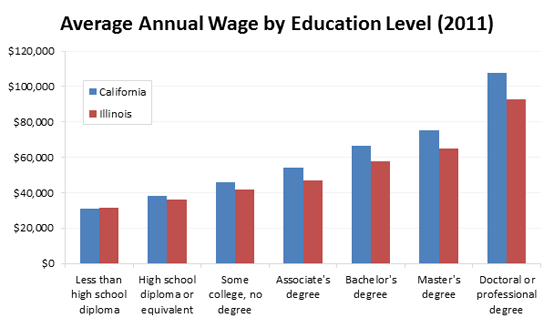Chmura's models and analytics, which form the backbone of our flagship product, JobsEQ, were recently utilized by a leading public policy think-tank, America's Edge, to highlight the skills gap that exists in California and Illinois. In part, through the use of forecasts of occupational supply and demand contained in JobsEQ, America's Edge was able to empirically demonstrate the skills-gap that exists in these states, particularly at the mezzanine level (jobs requiring some post-secondary training but less than a full bachelor's degree) of education. There was also a pronounced shortage of workers with Science, Technology, Engineering, and Math (STEM) skill-sets, which will increasingly be important to these economies as STEM-related jobs are growing faster than overall job growth.
For instance, utilizing Chmura's JobsEQ America's Edge found that in Los Angeles high-skilled jobs are projected to grow at roughly twice the rate of low-skilled jobs between 2010 and 2020, and that roughly 60 percent of the fastest growing occupations over the next 10 years will be jobs that require an education foundation in STEM. Based on this, they found that LA County has an undersupply of at least 81,000 high and middle-skilled workers. Similarly Illinois' job growth is highly skewed toward jobs that are either highly skilled (bachelor's degree or above) or middle-skilled (associate's degree, vocational degree or professional accreditation.) In Illinois the highest-skilled jobs are expected to grow at more than four times the rate of the lowest-skilled jobs. The Chicago Metropolitan Area has a projected deficit of over 90,000 middle-skilled workers alone.
The full reports for California (June) and Illinois (May) can be found at America's Edge website: http://www.americasedge.org/research/americas-edge-research/
America's Edges research conforms to independent research that Chmura conducted with National Association of Manufacturers, which found a pronounced skill bias in the manufacturing sector. Changes in technology relating to automation of processes and utilizing advance composite materials over the past decade have greatly increased the need for high skilled technicians and tradesmen while simultaneously reducing the need for low-skilled assembly and material moving positions. In almost every sector of the economy jobs requiring more skills, particularly STEM skills, command the higher wages and provide greater job security.
Even though this last recession has hit all workers, regardless of education, very hard, education is still the best avenue to securing higher wages. STEM-related occupations also command a premium across the country as well as in the states of Illinois and California.
